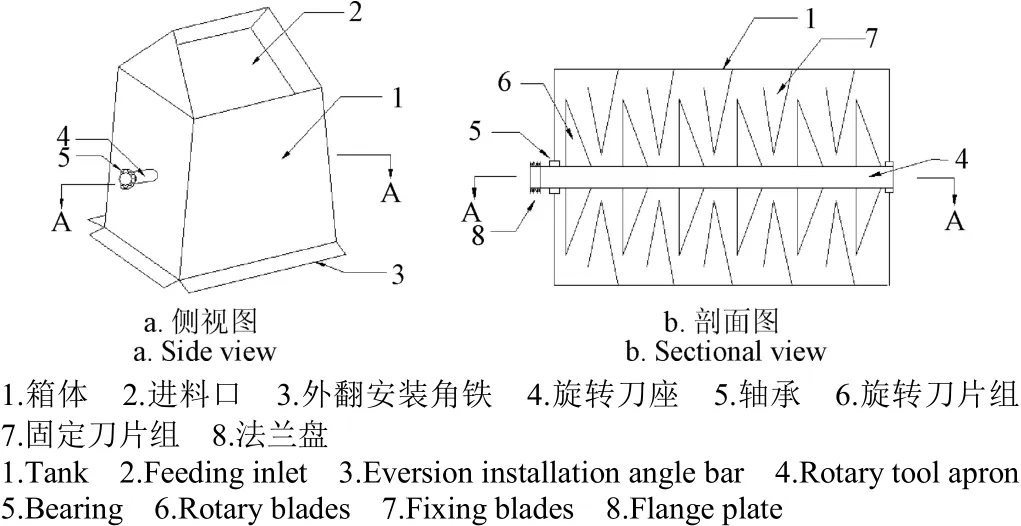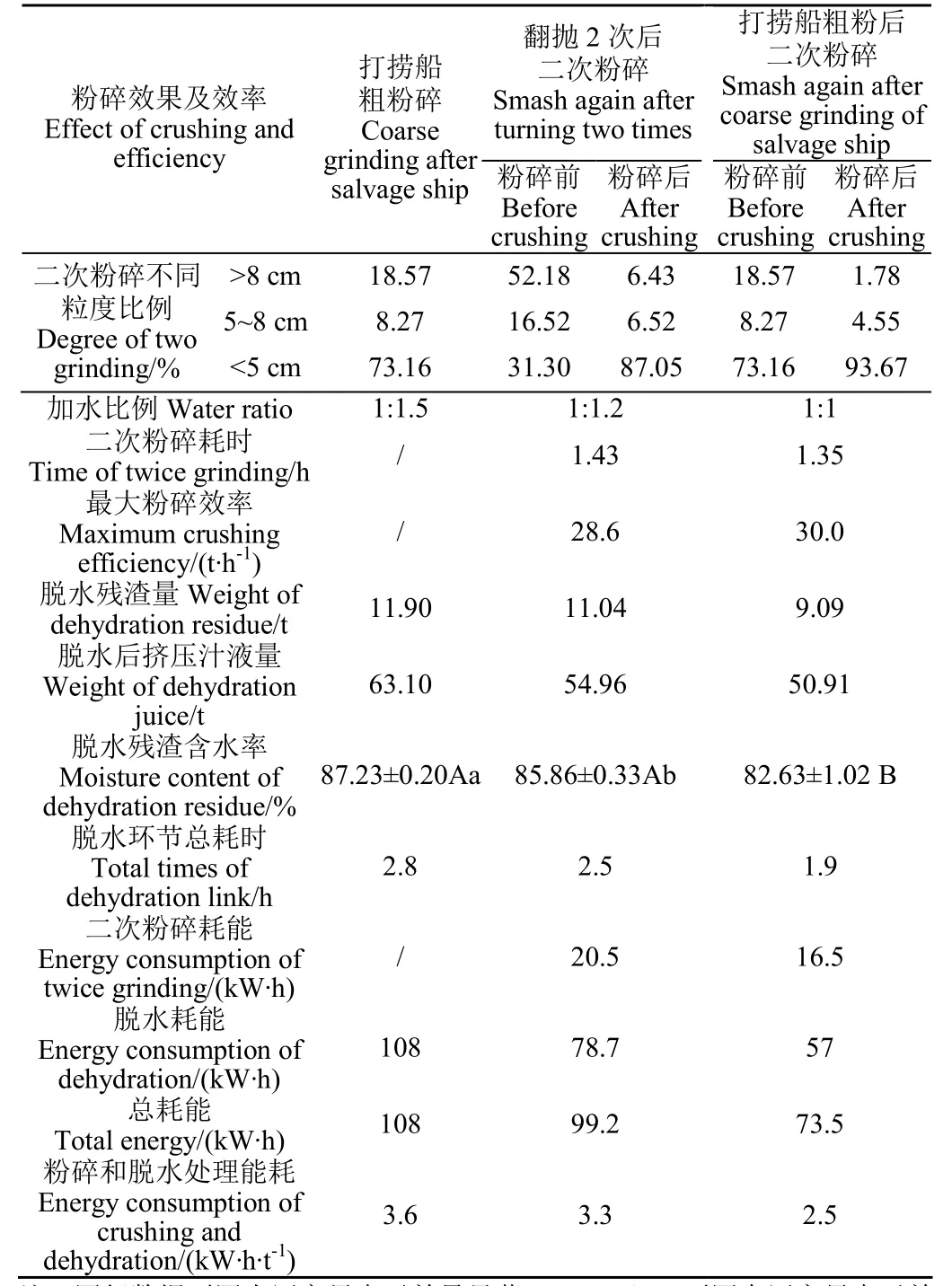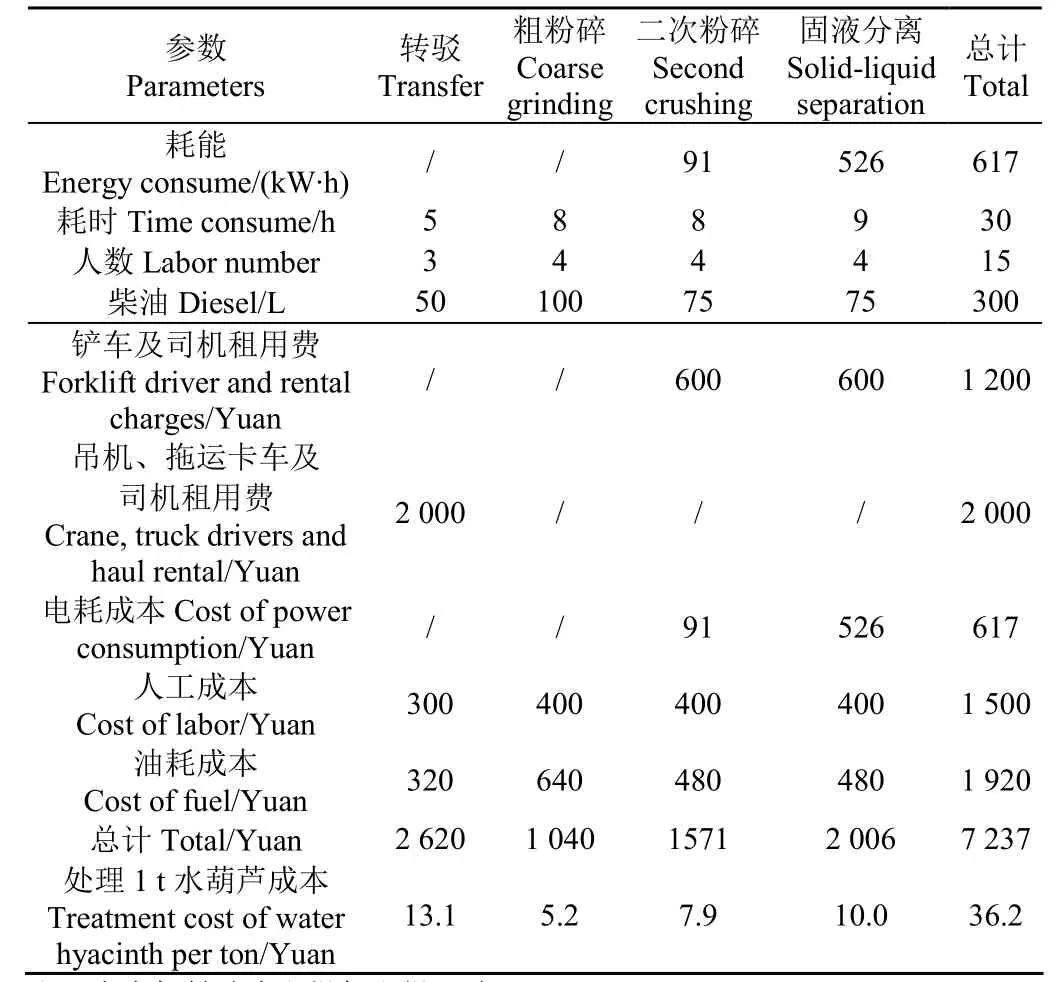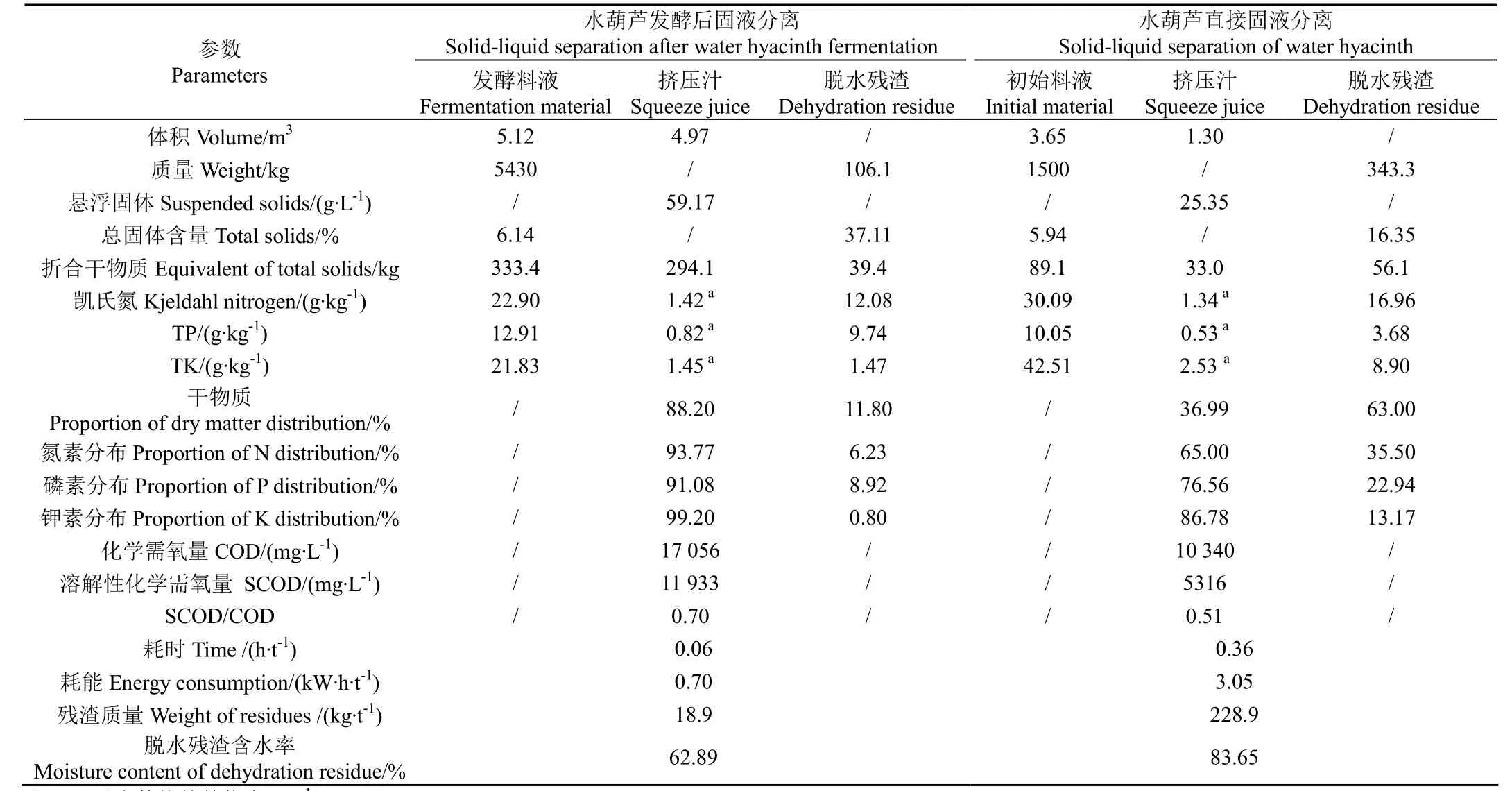水葫芦规模化脱水作业前粉碎预处理方案中试比选
杜 静,钱玉婷,靳红梅,徐跃定,黄红英,常志州
水葫芦规模化脱水作业前粉碎预处理方案中试比选
杜 静,钱玉婷,靳红梅,徐跃定,黄红英,常志州※
(江苏省农业科学院循环农业研究中心;江苏省农业废弃物资源化工程技术研究中心,南京 210014)
该文以建成的水葫芦中试示范工程为试验平台,通过对脱水前不同的工程预处理方案进行比较研究,并分析各处理环节的成本构成,以期为水葫芦规模化处理处置工程获得低本高效的整体解决方案提供理论依据。结果表明,从不同粉碎处理方式的能耗角度考虑,采用打捞船粗粉后二次粉碎的预处理方式有利于降低水葫芦脱水环节的能耗,粉碎和脱水处理1 t水葫芦需2.5 kW·h;通过对不同的打捞处置方案分析发现,采用打捞船粗粉处理上岸方式,可大大降低其转驳成本,减少岸上粉碎环节,从而提高粉碎和脱水处理能力,降低作业环节成本,并且打捞船粗粉方式的减容率达70.61%,使转驳运输能力提高3.4倍;水葫芦经厌氧发酵后的固液分离效果明显优于水葫芦直接固液分离,其脱水残渣含水率为62.89%,脱水1 t经厌氧发酵处理后的水葫芦仅需0.06 h和0.7 kW·h。该研究结果为最终形成“打捞船粗粉碎-转驳-二次粉碎-脱水”的水葫芦处理处置工程方案奠定了坚实基础。
脱水;生物质;成本;水葫芦;预处理
杜 静,钱玉婷,靳红梅,徐跃定,黄红英,常志州. 水葫芦规模化脱水作业前粉碎预处理方案中试比选[J]. 农业工程学报,2017,33(15):266-271. doi:10.11975/j.issn.1002-6819.2017.15.034 http://www.tcsae.org
Du Jing, QianYuting, Jin Hongmei, Xu Yueding, Huang Hongying, Chang Zhizhou. Comparison and selection of smash pretreatment scheme before dehydration in large scale for water hyacinth[J]. Transactions of the Chinese Society of Agricultural Engineering (Transactions of the CSAE), 2017, 33(15): 266-271. (in Chinese with English abstract) doi:10.11975/j.issn.1002-6819.2017.15.034 http://www.tcsae.org
0 引 言
水葫芦(学名凤眼莲),隶属雨久花科凤眼莲属,是一种外来生物,原产于南美洲委内瑞拉等国家,它是一种生态入侵能力极强的水生维管植物,是亚热带和温带河、湖水面广泛生长的一种水草[1],2003年被国家环保总局列入16种有害入侵物种名单,并被列为世界十大有害草种之一[2]。然而,水葫芦又是一种繁殖能力强,对氮磷等营养元素和部分有机污染物有较强富集、吸收和促进降解能力的水生植物,对不同类型污染水体均显示出良好的净化效果[3-6],在污染水体治理研究及工程实践中已逐步被认可[7-10]。近几年的研究结果表明,有计划地对水葫芦实施规模化控制性种养、机械化采收,并科学合理地进行后续处置,可以有效改善富营养化水体水质和规避二次污染的威胁[11-13]。
对于水葫芦的处理处置,主要包括水葫芦采收后的转运、粉碎、脱水及后续资源化利用(如能源化、饲料化和材料化等)等环节[14-18],其中,由于水葫芦植株含水量高达90%以上,脱水处置是其后续资源化、无害化利用的关键,脱水程度低成为其后续处理的瓶颈[7]。目前国内外已有较多文章和专利针对水葫芦二次利用的脱水干燥作了相关介绍。Solly等[19]将初始含水率为95.8%的水葫芦在25 ℃、湿度68%条件下自然晾干15 d后,可使其含水量仅降低至72%。与传统的风干、自然晾晒相比,机械脱水不仅占地小、效率高、处理及时,而且产生的水葫芦汁便于收集,不会产生二次污染。Innocent等[20]采用直接烘干的形式,进行了水葫芦烘干脱水特性研究,结果表明随着烘干温度的升高,其烘干率也相应提高。虽然采用自然晾干与机械直接烘干等方式,可以有效降低水葫芦水分,且水葫芦中氮、磷等养分损失有限,但因其脱水时间长或成本高均难在实践中大规模应用。查国君等[21]在水葫芦固液分离后产沼气研究中提及水葫芦脱水残渣的含水率为83.18%,但脱水的设备及技术未作说明。Akendo等[22]研究设计了适合的烘干设备,虽然可以将水葫芦含水率降至91%,但是成本比较高。王岩等[7]首次将辊轮式压榨机应用于水葫芦脱水,经3次挤压后,水葫芦渣的含水率为65%~68%。
笔者在前期工作中针对水葫芦脱水方式[23]、螺旋式固液分离养分损失规律[24]以及不同粉碎度[25]等影响因素已开展了相关研究,同时对优化后的粉碎水葫芦进行了30 t/批次的中试脱水试验。然而,上述研究仅对脱水环节进行了效果、处理效率及成本分析,难以为规模化处理处置工程提供较为完善的整体解决方案。因此,本文以建成的水葫芦中试示范工程(日处理能力200 t)为试验平台,通过对脱水前不同的工程预处理方案进行比较研究,并分析不同解决方案下各处理环节的成本构成,以期为水葫芦规模化处理处置工程提供低本高效的整体解决方案。
1 材料与方法
1.1 试验材料
新鲜水葫芦采自江苏省常州市武进水葫芦示范基地,其基本性状见表1,该文中涉及整水葫芦(指未粉碎水葫芦,即整棵打捞)、粉碎水葫芦(指经过不同粉碎方式处理后的水葫芦物料)。

表1 新鲜水葫芦基本性状(养分以干基计)Table 1 Basic properties of fresh water hyacinth (dry base for nutrients)
1.2 试验设备
1.2.1 水葫芦机械打捞船
采用张家港市海丰水面环保机械有限公司生产的HF226B-PT型水葫芦机械打捞船。船上配备有粉碎设备(即江苏省农业科学院自行研发的漂浮植物高效减容装置[26],其粉碎原理为采用卧式,固定刀片与活动刀片交叉分布。
1.2.2 翻堆机
采用河南荥阳丰裕机械设备厂生产的FPJ15型自行式翻堆机,翻堆宽度为2 000 mm,翻堆高度600~800 mm,处理能力为400~500 m3/h。其工作原理为,通过设备下挂装配的旋转刀,对水葫芦或肥料原料实施翻拌、切割破碎、混合和移堆作业。
1.2.3 水葫芦二次粉碎机
采用自行研制的水生植物专用粉碎机(即卧式甩刀粉碎机[27],见图1,型号SHJ-400型,处理能力20~30 t/h,电动机功率P=7.5 kW,频率f为50 Hz,其粉碎原理为采用卧式,通过旋转刀座上的6个旋转刀片组与箱体上的5个固定刀片组依次相间形成咬合)。

图1 水生植物专用粉碎机示意图Fig.1 Schematic drawing on special grinder with aquatic plant
1.3 试验设计
1)水葫芦打捞及水上运输方式:试验采用机械打捞船进行水葫芦打捞,采用2种打捞处置及运输方式,包括整水葫芦打捞后装入运输船舱和经打捞船粗粉碎处理后装入1 m3尼龙袋并通过运输船运送到岸(通常1艘运输船单趟运送12袋)。
2)水葫芦转驳方式:根据水上打捞及运输方式不同有所不同,其中整水葫芦通过岸基安装的塔式吊机(抓斗为八爪型)转驳,而打捞船粗粉碎物料则采用岸基航吊转驳。
3)水葫芦粉碎方式:试验设置3个处理组(打捞船粗粉碎,整水葫芦上岸后经翻抛机翻抛2次后再经专用粉碎机二次粉碎处理,打捞船粗粉碎后再经专用粉碎机二次粉碎处理)。
每次试验水葫芦处理量为30 t。试验设备及工艺路线示意图如图2所示,处理工艺采用即时粉碎即时脱水方式,即新鲜水葫芦经粉碎预处理后被投入调节池,然后加水混合(仅初次加水,后续则采取汁液回用)后经立式潜污泵[28]抽吸入螺旋式固液分离机(功率P=11 kW,螺旋挤压通道有效直径D=400 mm,处理量为6~10 t/h,出渣含水率80%~85%)进行脱水处理,挤压汁液一部分回用至调节池(回用量以调节粉碎水葫芦与水比例为1:0.6),多余部分则进入挤压汁贮存池,作为后续资源化利用环节的原料。

图2 水葫芦脱水设备及工艺路线示意图Fig.2 Schematic drawing of device and craft route on dehydration with water hyacinth
1.4 测试方法
水葫芦粉碎粗细测定:以5和8 cm为分界,将粉碎后水葫芦按照长度分类称取质量,然后采用各部分质量占总质量的百分比分布来表示粗细程度,试验重复5次,取平均值;电耗:单相电子式电能表DDSY879-D;残渣质量:用保衡电子秤TCS-100称质量;悬浮物浓度(SS)和挤压汁养分分析参照《水和废水监测分析方法》[29];残渣养分测定参照《土壤农化分析》[30]。
1.5 数据分析
采用Excel 2003进行数据分析。
2 结果与分析
2.1 不同粉碎方式对水葫芦粉碎和脱水效果的影响
不同粉碎方式对水葫芦粉碎和脱水效果的影响如表2所示。从表2来看,经不同粉碎方式处理后水葫芦物料的粗细程度有所不同,按照物料粗细程度:打捞船粗粉料>翻抛2次后二次粉碎料>打捞船粗粉后二次粉碎料,其中打捞船粗粉后二次粉碎料中最细物料中小于5 cm的占93.67%(由于吸料泵口最大的有效吸料长度为5 cm),并且随着物料变细,其挤压脱水时为保证顺畅抽吸所需加水的比例也相应降低;从水葫芦脱水残渣的含水率来看,各处理差异显著(P<0.05),以打捞船粗粉后二次粉碎方式的残渣含水率为最低,达82.63%;从脱水耗能情况来看,物料变细后,脱水耗能随之减少,其中打捞船粗粉后二次粉碎料的脱水耗能为57 kW·h,仅为打捞船粗粉料方式的一半,即使加上粉碎时的能耗仍低于未经二次粉碎的处理。可见,从能耗角度考虑,采用打捞船粗粉后二次粉碎的预处理方式有利于降低水葫芦脱水环节的能耗,粉碎和脱水处理1 t水葫芦需2.5 kW·h。

表2 不同粉碎方式对水葫芦粉碎和脱水效果的影响(以处理量30 t计)Table 2 Effects of different grinding methods on water hyacinthpulverization and dehydration (processing capacity with 30 t)
为了考察不同粉碎方式对水葫芦脱水过程中脱水残渣和挤压汁中养分分布的影响,试验采集了经不同粉碎方式脱水前后的残渣及挤压汁,检测分析样品中的N、P、K养分情况,如表3所示。从表3中可以看出,不论水葫芦粉碎程度如何,经固液分离后,挤压渣中养分以N素和P素为主,而挤压汁中则以K素为主,并且随着水葫芦粉碎程度的增加,挤压渣中N、P、K养分均逐渐向挤压汁中转移,可能由于粉碎度提高导致水葫芦细胞破碎程度增加,这与笔者前期研究结果相一致[26]。

表3 不同粉碎方式下水葫芦固液分离养分分布比较Table 3 Comparison of nutrient distribution in solid liquid separation of different types of water hyacinth
2.2 不同方式下水葫芦处理效果及运行成本分析
2.2.1 运行成本分析
依据水葫芦到岸时物料状态差异,比较整水葫芦和打捞船粗粉后物料的预处理效率及成本。从表4可以看出,以日处理量200 t为计,预处理1 t整水葫芦需36.2元,是打捞船粗粉上岸方式的1.8倍,其中转驳∶粉碎∶固液分离=1∶1∶0.76,而打捞船粗粉处理时转驳∶粉碎∶固液分离=1∶3.6∶4.5,其转驳成本仅为整水葫芦上岸方式的1/5,表明采用打捞船粗粉处理上岸方式,可大大降低其转驳成本,减少岸上粉碎环节,从而提高粉碎和脱水处理能力,降低作业环节成本。

表4 水葫芦脱水处理各环节运行成本明细Table 4 Details of operation cost of water hyacinth dehydration treatment
2.2.2 减容效果分析
为了考查不同粉碎方式下水葫芦粉碎和固液分离的减容效果,以均长约50 cm的水葫芦为试验材料,研究整水葫芦经翻抛2次后入二次粉碎机、整水葫芦入二次粉碎机和打捞船粗粉料3种处理方式下粉碎和脱水环节对水葫芦的减容效果,每批次试验水葫芦量为25 t,如图3所示。

图3 不同粉碎方式下水葫芦固液分离减容效果比较Fig.3 Comparison of reducing volume effects of solid liquid separation in different crushing methods
从图3分析来看,不同粉碎方式对水葫芦粉碎和脱水的减容效果差异明显,从粉碎减容效果来看,采用翻抛机翻抛粉碎1次、2次以及进一步经二次粉碎机粉碎的减容率分别为40.32%、53.32%和76.81%,而整水葫芦直接经二次粉碎机粉碎后,其减容率为74.69%,与翻抛2次后二次粉碎作业的效果相当(76.81%),并且略高于打捞船粗粉碎的减容效果(70.61%);而从固液分离减容效果来看,利用打捞船粗粉料直接固液分离方式,其脱水处理的减容率最高(达90.49%)。此外,与打捞及运输整水葫芦处理方式相比,采用打捞船粗粉碎作业处理方式,利用相同吨位的运输转驳船,可多运输3.4倍的水葫芦原料。综上可看出,采用打捞船粗粉碎作业方案,可实现较好减容效果的同时,加快水葫芦物料转运效率。
2.3 固液分离效果比较
为了考查水葫芦厌氧发酵前后固液分离效果的差异,以水葫芦打捞船粗粉碎后二次粉碎作业的物料为供试原料,研究水葫芦直接固液分离与厌氧发酵后固液分离的脱水效果及养分分布规律。如表5所示,首先从各处理固液分离过程中的干物质分布规律来分析,水葫芦经过发酵后再进行固液分离,约88.20%的干物质进入挤压汁,远大于水葫芦直接固液分离的处理,仅36.99%,表明经过厌氧发酵处理后,水葫芦纤维组织已基本被破坏,更多的已经溶解于发酵液中,导致固液分离时干物质能够逃离筛网的阻挡,最终随挤压汁流走,而水葫芦直接固液分离处理中,由于水葫芦物料粉碎后仅有少量组织细胞被破坏,更多的大颗粒物质只能随残渣排出;其次,从固液分离过程中的养分分布来分析,经过厌氧发酵处理后,各养分进入挤压汁的比例高达90%以上,其中以钾素为最高,达99.20%,氮素次之,磷素最低,为91.08%,而水葫芦直接固液分离处理的为钾素(86.78%)>磷素(76.56%)>氮素(65.00%),分析其原因可能是水葫芦体内的氮素和磷素大多以有机态存在,而钾素几乎都以无机离子态存在,并且经过厌氧发酵后,氮素更多的转化为溶解态,而磷素部分被用于供给微生物繁殖的核酸合成,并吸附于水葫芦大颗粒组织上,导致固液分离时有部分无法穿过筛网而进入残渣中。另外,从SCOD/COD的比值来看,经过发酵处理后挤压汁中的SCOD/COD(0.70)大于直接固液分离处理(0.51),表明发酵后挤压汁中有更多的溶解态有机物。

表5 不同的水葫芦处理方式下固液分离效果比较Table 5 Comparison of solid-liquid separation effect under different water hyacinth treatments
从处理效率分析,固液分离1 t经厌氧发酵处理后的水葫芦需要0.06 h、0.7 kW·h,分别为直接固液分离处理的16.67%、22.95%,而挤压脱水后的残渣含水率为62.89%,低于直接固液分离处理(83.65%),获得残渣量仅为18.9 kg,相当于直接固液分离处理的8.26%。
综上所述,水葫芦经厌氧发酵后的固液分离效果明显优于水葫芦直接固液分离,其脱水残渣含水率为62.89%,脱水1 t经厌氧发酵处理后的水葫芦仅需0.06 h和0.7 kW·h。
3 结 论
1)从不同粉碎处理方式的能耗角度考虑,采用打捞船粗粉后二次粉碎的预处理方式有利于降低水葫芦脱水环节的能耗,粉碎和脱水处理1 t水葫芦耗能2.5 kW·h;
2)通过不同的打捞处置方案分析发现,采用打捞船粗粉处理上岸方式,可大大降低其转驳成本,减少岸上粉碎环节,从而提高粉碎和脱水处理能力,降低作业环节成本,并且打捞船粗粉方式的减容率达70.61%,使转驳运输能力提高3.4倍;
3)水葫芦经厌氧发酵后的固液分离效果明显优于水葫芦直接固液分离,其脱水残渣含水率为62.89%,脱水1 t经厌氧发酵处理后的水葫芦仅需0.06 h和0.7 kW·h。
[1] 李博,廖成章,高雷,等. 入侵植物凤眼莲管理中的若干生态学问题[J]. 复旦学报:自然科学版,2004,43(2):267-274.
Li Bo, Liao Chenzhang, Gao Lei, et al. Strategic management of water hyacinth (Eichhornia crassipes), an invasive alien plant[J]. Journal of Fudanuniversity: Natural Science, 2004, 43(2): 267-274. (in Chinese with English abstract)
[2] 孙超,陈振楼,毕春娟,等. 黄浦江上游水源保护区不同河段水葫芦最佳治理对策[J]. 杂草科学,2008(3):14-17.
Sun Chao, Chen Zhenlou, Bi Chunjuan, et al. Optimal control of water hyacinth in different reaches of Huangpu River water source protection area[J]. Weed Science, 2008(3): 14-17. (in Chinese with English abstract)
[3] Reddy K R, Campbell K L, Graetz D A, et al. Use of biological filters for treating agricultural drainage effluents[J]. J Environ Qual, 1982, 11(4): 591-595.
[4] Pinto C L R, Caconia A, Souza M M. Utilization of water hyacinth for removal and recovery of silver from industrial wastewater[J]. Water Science and Technology, 1987, 19(10): 89-101.
[5] Malik A. Environmental challenge vis a vis opportunity: the case of water hyacinth[J]. Environmental International, 2007, 33(1): 122-138.
[6] 展巨宏,李强,邓莎,等. 紫根水葫芦对富营养化水体中氮磷的净化效果研究[J]. 地球与环境,2014,42(3):389-396.
Zhan Juhong, Li Qiang, Deng Sha, et al. Purification effect of eutrophic water body by purple-root water hyacinth[J]. Earth and Environment, 2014, 42(3): 389-396. (in Chinese with English abstract)
[7] 王岩,张志勇,张迎颖,等.一种新型水葫芦脱水方式的探索[J]. 江苏农业科学,2013,41(10):286-288.
Wang Yan, Zhang Zhiyong, Zhang Yingying, et al. Study on a new dehydration method of water hyacinth[J]. Jiangsu Agricultural Sciences, 2013, 41(10): 286-288. (in Chinese with English abstract)
[8] 袁蓉,刘建武,成旦红,等. 凤眼莲对多环芳烃(萘)有机废水的净化[J]. 上海大学学报:自然科学版,2004,10(3):272-276.
Yuan Rong, Liu Jianwu, Cheng Danhong, et al. Removal of naphthalene by Eichhornia Crassipe Solms and study on the mechanism[J]. Journal of Shanghai University: Natural Science, 2004, 10(3): 272-2760. (in Chinese with English abstract)
[9] 夏会龙,吴良欢,陶勤南. 凤眼莲植物修复水溶液中甲基对硫磷的效果与机理研究[J]. 环境科学学报,2002,22(3):329-332.
Xia Huilong, Wu Lianghuan, Tao Qinlan. Phytoremediation of methyl parathion by water hyacinth (Eichhorniacrassipessolms)[J]. ACTA Scientiae Circumstantiae, 2002, 22(3): 329-332. (in Chinese with English abstract).
[10] 王云英,周洪文,彭慧,等. 水葫芦污水治理及资源化利用研究进展[J]. 江苏农业科学,2012,40(7):313-317.
Wang Yunying, Zhou Hongwen, Peng Hui, et al. Research progress on wastewater treatment and resource utilization of water hyacinth[J]. Jiangsu Agricultural Sciences, 2012, 40(7): 313-317. (in Chinese with English abstract)
[11] Wang Z, Zhang Z, Zhang J, et al. Large-scale utilization of water hyacinth for nutrient removal in Lake Dianchi in China: The effects on the water quality, macrozoobenthos and zooplankton[J]. Chemosphere, 2012, 89(10): 1255-1261.
[12] 严少华,王岩,王智,等. 水葫芦治污试验性工程对滇池草海水体修复的效果[J]. 江苏农业学报,2012,28(5):1025-1030.
Yan Shaohua, Wang Yan, Wang Zhi, et al. Remediation effects of experimental project using water hyacinth for pollutioncontrol in the Lake Caohai, Dianchi[J]. Jiangsu Journal of Agricultural Science, 2012, 28(5): 1025-1030. (in Chinese with English abstract)
[13] 何俊,张宪中,殷文健. 太湖及其入湖荡控制性种养水葫芦示范工程及效果分析[J]. 安徽农业科学,2016,44(35):133-136.
He Jun, Zhang Xianzhong, Yin Wenjian. Effect of planting demonstration project for Taihu lake and its control with water hyacinth[J]. Journal of Anhui Agricultural Sciences, 2016, 44(35): 133-136. (in Chinese with English abstract)
[14] Almoustapha O, Kenfack S, Millogorasolodimby J. Biogas production using water hyacinths to meet collective energy needs in a sahelian country[J]. Field Actions Science Reports, 2009, 2(1): 72-77.
[15] Ganesh P S, Ramasamy1 E V, Gajalakshmi S, et al. Extraction of volatile fatty acids (VFAs) from water hyacinth using inexpensive contraptions, and the use of the VFAs as feed supplement in conventional biogas digesters with concomitant final disposal of water hyacinth as vermin compost[J]. Biochemical Engineering Journal, 2005, 27: 17-23.
[16] Gajalakshmi S, Ramasamy E V, Abbasi S A. High-rate composting-vermicomposting of water hyacinth (Eichhorniacrassipes, Mart. Solms)[J]. Bioresource Technology, 2002, 83: 235-239.
[17] Singhal V, Rai J P. Biogas production from water hyacinthand channel grass used for phytoremediation of industrial effluents[J]. Bioresour Technol, 2003, 86: 221-225.
[18] Kivaisi A K, Mtila M. Production of biogas from water hyacinth (Eichhornia crassipes) (Mart Solms) in a two-stage bioreactor[J]. World Journal of Microbiology & Biotechnology, 1998, 14: 125-131.
[19] Solly R K, Thyagarajan G. Integrated Rural Development With Water Hyacinth[C]// Proceedings of The International Conference On Water hyacinth, 1984: 70-78.
[20] Innocent C O Akendo, Lawrence O Gumbe, Ayub N Gitau.“Dewatering and Drying Characteristics of Water Hyacinth(Eichhornia Crassipes) petiole. Part II. Drying characteristics”[J]. Agricultural Engineering International: the CIGRE journal Manuscript, 2008, 3:7-33.
[21] 查国君,张无敌,尹芳,等. 滇池水葫芦固液分离后的沼气发酵研究[J]. 中国野生植物资源,2008,27(2):36-38.
Zha Guojun, Zhang Wudi, Yin Fang, et al. Seperating solid and liquid of dianchi’s Eichhomiacrassipes for biogas generation[J]. Chinese Wild Plant Resources, 2008, 27(2): 36-38. (in Chinese with English abstract)
[22] Innocent C O Akendo, Lawrence O Gumbe, Ayub N Gitau.“Dewatering and drying characteristics of water hyacinth (EichhorniaCrassipes) petiole. Part I. Dewatering characteristics”[J]. Agricultural Engineering International: the CIGRE Journal Manuscript, 2008, 2:7-32
[23] 杜静,常志州,叶小梅,等. 水葫芦粉碎程度对脱水效果影响的中试[J]. 农业工程学报,2012,28(5):207-212.
Du Jing, Chang Zhizhou, Ye Xiaomei, et al. Pilot-scale study on dehydration effect of water hyacinth with different pulverizationdegree[J]. Transactions of the Chinese Society of Agricultural Engineering (Transactions of the CSAE), 2012, 28(5): 207-212. (in Chinese with English abstract)
[24] 杜静,常志州,叶小梅,等. 压榨脱水中水葫芦氮磷钾养分损失研究[J]. 福建农业学报,2010,25(1):104-107.
Du Jing, Chang Zhizhou, Ye Xiaomei, et al. Losses in nitrogen, phosphorus and potassium of water hyacinth dehydrated by mechanical press[J]. Fujian Journal of Agricultural Sciences, 2010, 25(1): 104-107. (in Chinese with English abstract)
[25] 杜静,常志州,黄红英. 水葫芦脱水工艺参数优化研究[J].江苏农业科学,2010(2):267-269.
Du Jing, Chang Zhizhou, Huang Hongying. Study on optimization of technological parameters of dehydrated with water hyacinth[J]. Jiangsu Agricultural Sciences, 2010(2): 267-269. (in Chinese with English abstract)
[26] 张志勇,刘海琴,刘国锋,等. 漂浮植物高效减容装置201020100683.5[P]. 2010-11-17.
[27] 杜静,杨新宁,常志州,等. 一种专用于水生植物的粉碎机201120099076.6[P]. 2011-11-16.
[28] 杜静,杨新宁,常志州,等. 抽取高浓度污料的立式潜污泵201120099096.3[P]. 2011-11-16.
[29] 国家环保局《水和废水监测分析方法》编委会. 水和废水监测分析方法[M]. 第3版. 北京:中国环境科学出社,1989.
[30] 鲍士旦.土壤农化分析[M]. 北京:中国农业出版社,2000:264-271.
Comparison and selection of smash pretreatment scheme before dehydration in large scale for water hyacinth
Du Jing, QianYuting, Jin Hongmei, Xu Yueding, Huang Hongying, Chang Zhizhou※
(Circular Agriculture Research Center, Jiangsu Academy of Agricultural Sciences; Jiangsu Agricultural Waste Treatment and Recycle Engineering Research Center, Nanjing 210014, China)
Water hyacinth (Eichhorniacrassipes) is a noxious weed that has attracted worldwide attention due to its fast spread and congested growth, which lead to serious problems in water way transportation, irrigation, and power generation. On the other hand, it can be a valuable resource with several unique properties. Water hyacinth contains more than 95% water but due to its fibrous tissue and a high energy and protein content, it can be used for a variety of useful applications. In order to achieve theoretical basis for large-scale treatment and disposal project that have overall solution of low cost and high efficiency with water hyacinth, a comparative study of different engineering pretreatment before dehydration and analysis of the processing cost were studied as the test platform of pilot demonstration project of water hyacinth. In this paper, the process of instant smash instant dehydration was used, and two kinds of water hyacinth salvage and water transportation (the water hyacinth loaded directly into the cabin, and the water hyacinth after coarse crushing for salvage ship loaded into 1 m3nylon bags and transported to the shore by ship), two modes of shore transfer (tower crane airlines and shore based crane) and three methods of crushing (coarse crushing of salvage ship, smash again by turning the machine two times, and smash again after coarse grinding on salvage ship)were designed and experimented in this study. The results showed that the pretreatment method of two times after the salvage of coarse powder was helpful to reduce the energy consumption of processing dehydration of water hyacinth. The treatment of per tons for water hyacinth needed about 2.5 kW·h. Through analysis of energy consumption of different crushing methods, the results showed that the method of two times after the salvage of coarse powder reduced the transportation cost, along with the need for shore crushing. It improved the grinding and dehydration treatment ability, reduced operation cost and the volume by 70.61%, and increased the transport capacity by 3.4 times for the method of salvage ship coarse powder. After the separation of water hyacinth, the content of N and P were the main nutrients in the extrusion residue, while the K value was the main factor in the extrusion juice. With the increase of the degree of grinding for water hyacinth, the N, P, K nutrient in the extrusion residue was gradually transferred to the juice. The solid-liquid separation effect of water hyacinth after anaerobic fermentation was better than that of water hyacinth direct solid-liquid separation in terms of residue water content reduction and nutrient recovery, and the moisture content of the dewatering residue was reduce to 62.89%, and it was only about 0.06 hours and about 0.7 kW·h after dehydration of per tons with water hyacinth. The results of this study have laid a solid foundation for the final design of the water hyacinth treatment and disposal, which is the treatment scheme of“rough grinding of salvage-transfer-twice crushing-dehydration”.
dehydration; biomass; cost; water hyacinth; emergency treatment
10.11975/j.issn.1002-6819.2017.15.034
X705
A
1002-6819(2017)-15-0266-06
2017-02-06
2017-07-07
江苏省重点研发计划(BE2015356);国家科技支撑计划(2015BAL04B05);国家水体污染控制与治理科技重大专项(2012ZX07101-004)作者简介:杜 静,男(汉族),四川眉山人,助理研究员,主要从事农业固体废弃物资源化研究。南京 江苏省农业科学院循环农业研究中心,210014。Email:dj1982111@126.com
※通信作者:常志州,男(汉族),江苏句容人,研究员,主要从事农业固体废弃物资源化研究。南京 江苏省农业科学院循环农业研究中心,210014。Email:czhizhou@hotmail.com

